Meeting of the Board of Regents | December 2009
|
|
THE STATE EDUCATION DEPARTMENT/THE UNIVERSITY OF THE STATE OF NEW YORK/ALBANY, NY 12234 |
|
TO: |
|
|
FROM: |
John B. King |
|
SUBJECT: |
Regents 2010-11 Proposal on State Aid to School Districts |
|
DATE: |
December 14, 2009 |
|
STRATEGIC GOAL: |
1, 2, 3 and 5
|
|
AUTHORIZATION(S): |
SUMMARY
Issue for Action
Adoption of the Regents State Aid Proposal for school year 2010-11.
Reason(s) for Consideration
Policy decision.
Proposed Handling
The detailed State Aid proposal will come before the Subcommittee at their December meeting and the Subcommittee will make a recommendation to the full Board to approve.
Procedural History
The Regents Subcommittee on State Aid began its discussion about the development of the Regents 2010-11 State Aid proposal at its June 2009 meeting. Subcommittee members discussed Foundation Aid Principles and High School Reorganization. The Regents discussed at a joint meeting of the Audit and State Aid Subcommittees in June, A Review of School District Financial Condition, and in September 2009 the Regents Subcommittee discussed, Support for Universal Prekindergarten and Benefits of High Performance School Buildings. At the November meeting, the Regents Subcommittee reviewed the conceptual proposal, shared it with the full Board of Regents and gave general support to the conceptual proposal. Comments the Department received from educational associations on the conceptual proposal have encouraged the Regents to consider an additional proposal concerning Instructional Materials Aid (page 13). No other changes have been made to this conceptual proposal since the November Regents meeting.
Background Information
In seeking to continue progress in providing the opportunity for all students to meet State learning standards, the Regents recognize that funding is one key component of a solution. In recognition of the fiscal crisis that the State is facing, the Regents proposal seeks to achieve adequacy over an extended period of years by supporting a modest increase in Foundation Aid in 2010-11 while simultaneously redirecting funds to those school districts which are currently furthest from measures of adequacy.
Recommendation
I recommend you take the following action:
VOTED that the Regents adopt the attached report as their proposal on State Aid to school districts for school year 2010-11.
Timetable for Implementation
Following the Regents approval of the final State Aid proposal for 2010-11, the Governor will issue his budget recommendations in January and will ask the Legislature to approve a State budget by April 1.
Attachment
Regents Detailed Proposal on
State Aid to School Districts
For School Year 2010-11
Table of Contents
Executive Summary ............................................................................................................. 4
Introduction and Statement of Need .................................................................................. 8
Recommendations .............................................................................................................. 11
Continue moving toward adequacy by maintaining commitment to the Foundation Aid funding formula and refining distribution of funds to support high-need districts 11
Maintain existing Contracts for Excellence ........................................................... 12
Restructure State funding for Universal Prekindergarten .................................... 12
Additional reforms to State Aid .............................................................................. 13
Suggestions for more efficient use of State and local resources ....................... 16
Conclusion ............................................................................................................................ 18
Figures
Share of Computerized Aid Increases for 2010-11 School Year ................................. 5
Aid Increases for 2010-11 School Year .......................................................................... 6
2010-2011 Regents State Aid Proposal—New York State ......................................... 7
- Graduation Rates for New York State Public Schools .............................................. 8
- School Tax Relief (2008-09) by School District Need Categories .......................... 9
- Age Distribution of New York State Teachers, 1985-2006 ....................................... 10
Regents Proposal on
State Aid to School Districts
For School Year 2010-11
Executive Summary
This year’s Regents State Aid proposal asserts that, despite the economic situation, we can and must move forward in our drive to put in place funding changes that provide all students with the opportunity for an adequate education. Overall it recommends a $469 million increase in General Support to Public Schools for next year. It is silent as to whether the State may invest additional stimulus funds in schools.
The Regents proposal advances two critical policy directions for school funding. First it puts Foundation Aid back on track with a modest 1.1 percent, $170 million, increase which grows over time and is fully phased in after ten years. This means that school districts will see changes in their school aid as they experience changes in enrollment and fiscal capacity, and it provides for responsible increases in future years.
Second, it recommends a small $53 million increase in State support for universal pre-k and that the State commit to a full phase in of this program for four year olds—for half-day programs within four years and for full-day programs within 10 years. These two aid programs will support school districts as they seek to raise student achievement and close performance gaps for their neediest students.
The Regents proposal recommends additional reforms to State Aid including making support for school construction more progressive. This will produce savings in the future and help to balance State support for school construction with State support for school operation.
The Regents proposal makes suggestions for more efficient use of State and local resources including encouraging school districts to construct green design, high performance school buildings and to use regional transportation and shared business office services to a greater extent. It also recommends the State streamline school district planning and reporting and require regional task forces to explore district or functional consolidation and report obstacles to reducing local costs to the State Education Department.
The economic crisis does not mean we can’t make progress in education. The Regents recommend the State put the Foundation Formula back on track, commit to making pre-k truly universal, and support strategic reductions in State and local education costs.
The table titled 2010-11 State Aid Proposal on page 7 provides the details of the Regents request.
The following pie chart shows the distribution of the computerized aids proposed by the Regents: 25 percent to New York City; six percent to the Big Four City School Districts, 16 percent to the high need urban/suburban districts, 21 percent to the high need rural districts and 32 percent to average and low need districts.
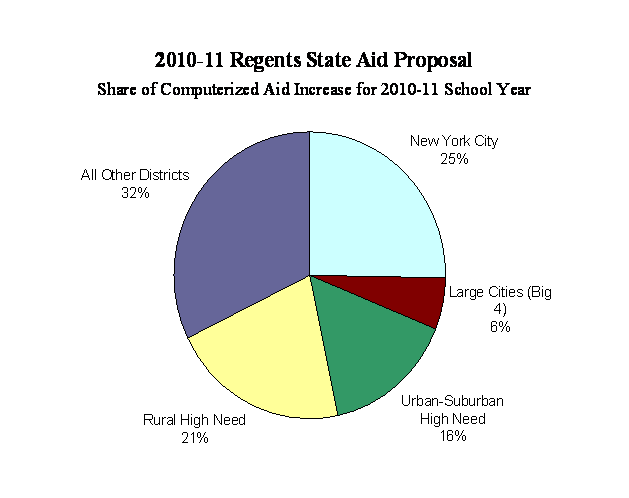
|
Note: This pie chart depicts the share of computerizes aids including Foundation Aid and many other categories as described in the chart on page 7. |
The following bar graph shows the distribution of the Regents proposal to high need and other districts. In the budget that the State enacted for 2009-10, approximately 65 percent of the increase was directed to high need districts. The Regents recommend that this percentage be increased for 2010-11 to approximately 68 percent.
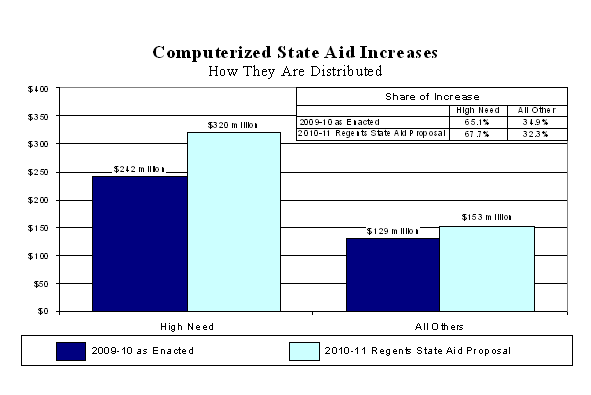
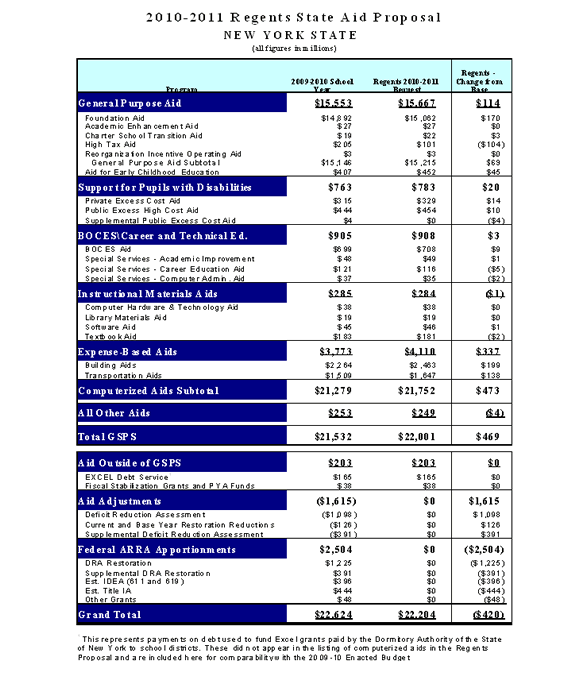
Graduating more students is a moral and economic imperative
A primary policy concern of the Board of Regents is the enactment of reforms necessary to ensure that students across the State have the resources to meet State learning standards. This concern is fueled by the fact that fewer than two-thirds of students graduate from high school, and in our large cities, half or fewer graduate. Even statewide fewer than 50 percent graduate among subgroups of students who are black, Hispanic, English language learners, and students with disabilities. (See Figure 1.) Increasing the number of students graduating from high school and succeeding in higher education and work will strengthen the State’s economy and ensure its economic viability.
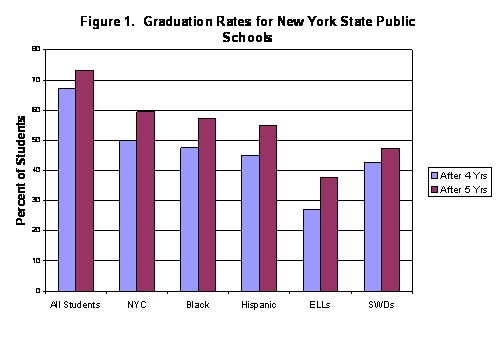
A poor economy is forcing New York State to change
In an effort to support increased learning around the State and to close the gap in student achievement, the Regents proposed a foundation formula, and the State enacted it in 2007. Progress towards the Regents goal of making dramatic achievement gains was made with the substantial aid increases in 2007 and 2008 and the additional Contracts for Excellence accountability requirements enacted for low-performing school districts around the State that received large aid increases. But before the end of 2008, the State, nation and world economies began to falter. New York suffered declining revenues resulting from a greatly reduced financial market and the lack of income and sales taxes due to job losses and a lack of consumer confidence. The State extended its initial phase in of Foundation Aid from four years to seven years.
Federal stimulus funds and STAR provided additional resources
The federal Recovery Act provided substantial funds for state stabilization over a two-year period. This allowed New York State to restore the proposed cut to State Aid and enact a budget that froze Foundation Aid for two years and extended the phase-in of the fully-funded foundation formula until 2013-14. The law required school districts with Contracts for Excellence to maintain their investments in programs to raise the achievement of students with the funding received in 2007 and 2008.
In addition to school aid, New York State provides property tax exemptions to New York State homeowners. The School Tax Relief (STAR) Program provides Basic and Enhanced STAR Property Tax Exemptions to New York State homeowners for their primary residence. Basic STAR is available to anyone who owns and lives in his or her own home. Enhanced STAR is available to senior homeowners whose incomes do not exceed a statewide standard. A middle class STAR exemption enacted in 2007 was discontinued in 2009. The State makes approximately $3 billion in payments each year to school districts to compensate them for reduced property tax receipts. Since STAR payments are linked to the value of the properties, more tax relief goes to school districts with higher property values. Figure 2 shows that the amount of tax relief payments per pupil is greater for average and low need school districts.
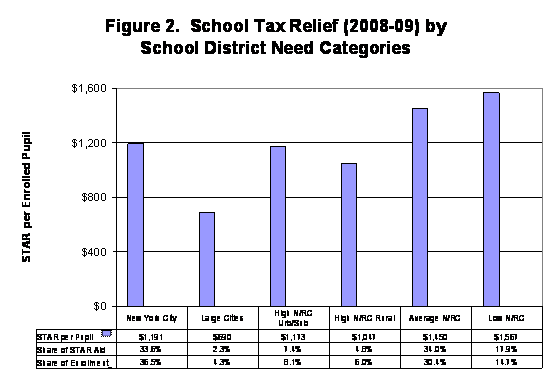
School districts are faced with a number of cost pressures
While federal stimulus funds provided much needed relief in the current school year, a number of factors affect the pursuit of educational adequacy. Each year that Foundation Aid is frozen, school districts that are highly dependent on State Aid get further behind than those that receive more of their funding from local revenues. These districts have to use a greater portion of their State funding to cover cost increases for energy and employee and retiree health care, rather than providing more educational opportunities to students. Federal stimulus funding will be discontinued after two years producing an approximately $1 billion budget gap for education that the State must fill in order to fund schools.
Retirement costs for school districts are growing. When financial markets are strong, school district contributions to employee retirement systems are low. School districts enjoyed a period of low contributions in the late 1990's. With the turn of the millennium this dynamic started to reverse as markets declined or grew more slowly and school district contributions rose precipitously. Figure 3 looks at the age distribution of New York State teachers and suggests that savings that districts previously enjoyed when higher paid veteran teachers retired and were replaced with lower cost teachers with fewer years of experience, are no longer available. Added to this, districts must pay the cost of retirement for a large group of retirees who are living longer.
Figure 3. Age Distribution of New York State Teachers, 1985-2006
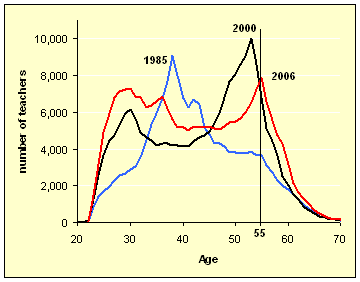
Source: James Wyckoff Presentation to the Board of Regents, 2007
The policy dilemma—how to raise student achievement in an economic crisis
The challenge before the Board of Regents for the coming school year is how to continue progress the State has made in providing the opportunity for all students to meet State learning standards, and that school districts have made in educating more students to these standards, despite the economic crisis. Are there efficiencies in the educational system that will free up more funds to support student learning? Can the State improve the distribution of State Aid in a way that is fair to all school districts while better accomplishing the State’s mission of providing an adequate education to all students? Are there key investments that if made will produce greater results for students and reduce costs in the future?
Recommendations
Continue moving toward adequacy by maintaining commitment to the Foundation Aid funding formula and refining distribution of funds to support high need districts
In order to provide all students with the opportunity to meet State learning standards, the Regents must ensure that all districts have the financial resources needed. The funding structure must be fair to both students and taxpayers. The emphasis must be first on the provision of inputs, e.g., highly qualified teachers, appropriate facilities and other educational resources, which are required to adequately educate students regardless of where they attend school.
State resources should be allocated on the basis of a district’s fiscal capacity, including regional costs and student needs. This is what the Foundation Aid formula was designed to accomplish and what was initiated with the statutory funding phase-in begun in 2007. However, the phase-in was extended from four to seven years and funding was frozen in 2009-10 and in 2010-11. While very serious fiscal challenges exist, the State must maintain its responsibility and commitment to seek adequate funding for all of our school districts by resetting the Foundation Aid base and beginning a new phase-in in 2010-11.
Experience has shown that when State Aid is frozen, there are inequitable consequences that have a disproportionate negative effect on high need school districts. These districts' resources are farthest from adequate and have a larger portion of their budget dependent on State Aid. The freeze affects a greater share of their budgets than districts that are less dependent on State Aid and which may be providing more than an adequate education at a reasonable tax rate.
Restoring the phase-in on a longer schedule will demonstrate the State’s good faith effort toward the structural realignment of resources intended in 2007. Adjustments to the formula that recognizes changes in student enrollment and district wealth will help to better target funds to the neediest students and to the districts that have the farthest to go to provide an adequate education. The current economic crisis has increased the number of students in poverty and the increased the associated educational needs. We must continue to make progress toward educational adequacy even while coping with the budget crisis.
Maintain existing Contracts for Excellence
The Contracts for Excellence (C4E) initiative is a comprehensive approach to targeting fiscal resources to raise the achievement of students with the greatest educational need. The State created C4E in 2007 which required that districts receiving a significant amount of new State Aid spend it on research-based programs with a track record of improving student achievement. C4E represented an historic commitment by the Legislature and Executive to provide accountability concerning the investment of significant new resources to give all students the opportunity to achieve greater success.
Districts were required to document student achievement growth associated with these expenditures. The law specified the amount of funding that could be spent to expand learning opportunities for students and the amount which could be used to continue existing district programs.
Recommendation
The Regents recommend that the State continue to require that current Contract for Excellence school districts meet Contract for Excellence accountability requirements unless all of the district’s schools are in good standing.
Restructure State funding for Universal Prekindergarten
State funding for Universal Prekindergarten (UPK), together with well planned and adequately funded early grade programs, gives all students a solid learning foundation. Research has documented the lasting impact of quality early childhood programs as an effective approach to supporting a more level playing field as children begin formal schooling. It is more cost effective to prevent the development of an achievement gap than it is to try and remediate the gap afterward. If the achievement gap is lessened from the start, the inevitable consequences of the gap are also impacted, such as a decline in the need for special education and academic intervention services, an increase in graduation rates, and increase in workforce earnings and a decrease in crime. Quality early childhood education makes good education and economic sense.
UPK was launched in 1998 with a statutory funding phase-in designed to reach statewide implementation within three years. Implementation efforts have stretched to a decade but only 67 percent of school districts, or 450 out of 677, currently offer the program and only 40 percent of the State’s four year olds participate. A primary goal for the program is to give all districts the option to participate and to improve access to UPK for all of the State’s four year olds, including children with disabilities. Restricted access to UPK limits the positive gains that a universal P-12 system could ensure.
The UPK funding formula is complex and funding has been unpredictable in the past. Consistent with other State initiatives, funding for UPK was frozen in 2009-10 to 2008-09 levels. In light of the research and tangible evidence regarding the many advantages of quality early childhood education for all students, the State should renew its commitment to a full phase-in of UPK. Better alignment of the UPK formula phase in with K-12 funding to provide more predictability to school districts is necessary to achieve statewide implementation. Additional flexibility in the use of funds would enable some districts to expand the provision of services from half-day to full-day. This flexibility would require legislative and regulatory changes and would need to be implemented in a manner that did not reduce the overall number of students participating.
Recommendation
It is recommended that the Regents support a restructuring of the UPK funding formula to provide more stability and greater predictability and that the State commit to a phase-in of UPK to be aligned with the phase-in schedule for the Foundation Aid formula.
Additional reforms to State Aid
Building Aid and building cost allowance
The current cost allowance formula determines the maximum cost to be aided when a district undertakes a building project. The formula is considered complex and has multiple moving parts, making it difficult to determine the appropriate maximum cost allowance for an adequate facility in today’s environment. It can impede long range planning and force districts to design spaces at odds with their educational program goals in order to secure the greatest amount of State funding.
In addition, modifying some existing facilities funding provisions would facilitate more targeted disbursement of State funding for capital construction.
Recommendations
The Regents recommend simplifying the maximum cost allowance calculation to facilitate better long-range planning and more efficient use of State funds. The law sets a reasonable cost ceiling for all capital projects. However, the current system, in some cases, forces a district to compromise the desired educational goal in order to achieve maximum reimbursement. The Regents propose that the State calculate a cost allowance based on a certain allotment of space and cost per enrolled pupil, according to the following formula:
Cost Allowance = Projected Pupil Enrollment x Allowed Square Feet
Per Pupil x Allowed Cost per Square Foot x Regional Cost Factor
The current New York State Labor Department Cost Index would be used to update allowable costs on a monthly basis. Unlike the Regents Regional Cost Index enacted for Foundation Aid, which is fundamentally a professional wage index, the New York State Labor Department cost index used for Building Aid is based solely on the wages of three major occupational titles critical to the building industry. A simplified cost allowance formula would offer greater educational flexibility, support more intelligent long-range planning of school capital needs, and promote ease of understanding and transparency.
The Regents recommend that the State take the following measures to eliminate or modify existing facilities funding provisions that increase costs to the State and do not result in improved facilities for educating students:
- For future projects, eliminate the selected building aid ratio option that allows districts to use their most favorable aid ratio going back to 1981-82. In cases where district wealth has increased over the years, the State is compensating a district based on historic data not their current needs. In conjunction with eliminating the selected building aid ratio, eliminate the 10 percent building aid incentive. This incentive funding is no longer needed and its elimination could provide future savings each year.
- Base the incidental cost allowance on actual construction expenses, not the theoretical maximum construction expenses submitted when the project was proposed. The current statutory method allows districts to undertake projects more limited in scope than what they originally proposed but bases the allowance for incidental expenses, such as site work including artificial turf fields, on the maximum cost allowance. As a result the State may pay aid for incidental costs that greatly exceed the cost of the project. This makes poor economic sense for the use of scarce education dollars.
- Limit Reorganization Incentive Building Aid after five years. Building Reorganization Incentive Aid on capital outlay, lease and debt service is subjected to the same requirements as regular Building Aid. Aid is provided for reorganization projects that have been approved by voters within five years of district consolidation and where the project is contained in the five-year capital reorganization plan. Limiting this aid after five years could save the
State money each year.
Limit High Tax Aid
High Tax Aid, which tends to benefit high wealth districts, was originally a one-year program but has been included in the frozen aid amounts for 2009-10 and 2010-11. Limiting the amount of High Tax Aid acknowledges the need to shift funding to meet educational adequacy while still recognizing the high tax burden that some districts face.
BOCES Aid
The Regents proposal seeks to maximize the potential of BOCES while improving the assessment of fiscal capacity for the distribution of BOCES Aid. It is recommended that there be an increase in the equalization of the BOCES Aid formula by eliminating the millage aid ratio option that benefits wealthier school districts. This would enhance the State’s role of providing educational opportunities by equalizing aid so that low-wealth districts receive more aid and wealthier districts receive less.
Provide flexibility in funding for instructional materials
Although the Governor and Legislature have provided support for instructional materials in the form of Textbook Aid and Software Aid, changes in education suggest the need for commensurate changes in State Aid.
First, instructional materials are increasingly available electronically so Textbook Aid was recently amended to allow textbooks in electronic format to be eligible for aid. This change blurs the distinction between Textbook Aid and Software Aid.
Second, schools throughout the State are designing science and mathematics curricula to provide an inquiry-centered instructional approach that involves the use of relevant equipment, professional materials, supplies and science kits or mathematics manipulatives, rather than textbooks. Such experiential learning has helped students master State standards and has supported State and national efforts to strengthen student preparation in mathematics and science.
Textbooks may not be the most appropriate instructional materials for kindergarteners. Instead of textbooks, early childhood educators use developmentally appropriate educational games and hands-on manipulatives that promote early literacy, numeracy, scientific inquiry, and social learning.
Recommendation
The Regents recommend that the Governor and Legislature consider options for providing school districts with greater flexibility in using state support for instructional materials such as by consolidating Textbook Aid and Software Aid into a new Instructional Materials Aid. The definition of eligible instructional materials should include equipment, materials, supplies, kits and other manipulatives used in the instruction of K-12 mathematics and science, and for kindergarten only, educationally-based materials such as developmentally appropriate games and hands-on manipulatives that promote early learning.
Suggestions for more efficient use of State and local resources
The State Aid Subcommittee has explored State Aid implications of several proposals for the efficient use of resources and recommends that the full Board consider them.
High Performance Buildings
There is ample support in the building industry for high performance “green” facilities which can be developed at comparable, or minimally higher costs, than traditional building expenditures but which more than pay for themselves with building longevity and reduced annual energy costs. While districts may need to secure more funding initially, the significant financial and operating benefits over the lifetime of high performance buildings merit consideration. It is anticipated that green design buildings will reduce energy consumption by about 25 percent. Buildings using green design and long lasting materials also offer an environment that is more conducive to learning. Studies on air quality, temperature control and natural lighting have substantiated the benefits of green buildings in the educational arena.
Mandate relief by streamlining school district planning and reporting
Over the past several years the Regents have supported legislative efforts to provide comprehensive mandate relief to school districts through the elimination of duplicative reporting while also authorizing the Commissioner to further streamline school district and BOCES planning and reporting. The Legislature and Governor responded by eliminating some requirements this year. Additional streamlining of planning and reporting is proposed to help the Department, BOCES and district staff to use information more strategically and comprehensively and focus Departmental staff resources on its core operational mission and responsibilities. Mandate relief legislation would require the Department to conduct a review of Commissioner’s regulations within a year and eliminate duplicative or unnecessary reporting requirements for school districts. Additional work is needed to achieve comprehensive reform.
Regional task forces to explore district or functional consolidation
There are many existing mechanisms for sharing of services and functional consolidations that could result in substantial cost reductions. They have been implemented in some parts of the State but are not widely used. There is a need to generate local sharing and consolidation initiatives that utilize the best practices of BOCES and school districts, using regional approaches to effectuate cost savings. Education Law should be amended to require BOCES to create regional task forces, with representation from BOCES and component school districts, including superintendents, school board members, parents and representatives from the business community, to study and make recommendations on opportunities for greater consolidation in each BOCES supervisory district. School district reorganization and functional consolidation should be considered for the purpose of reducing costs and increasing educational opportunity and achievement. The BOCES should be charged with reporting annually on consolidation efforts pursued, savings achieved or expected, and identifying obstacles to consolidation.
Promote regional transportation strategies
School districts currently spend approximately $2.8 billion for pupil transportation, for which they receive $1.5 billion in state aid or approximately 54 percent of the expense. Any transition to a regional model of pupil transportation will take a number of years. By starting with regionalization of nonpublic and special education transportation, along with some shared maintenance services, savings would accrue. A greater level of savings would accrue to those districts having the most out-of-district special education and nonpublic transportation services. Smaller districts, which might not want to consolidate, could share administrative and training staff. Additional savings will accrue as larger school districts take on the task of providing all the transportation services of smaller districts within their region. School districts could also move to a regional or cooperative model of bus purchasing producing a savings of 5 to 15 percent, depending upon the method school districts are currently using to purchase school vehicles. Regionalization of school bus maintenance would result in less duplication in the purchase of repair and maintenance equipment and construction of garage and bus storage facilities. Finally, over time there are potential cost savings to the State and local districts by adopting a true regional model of pupil transportation. Legislative changes would be required to pursue several of the suggestions noted.
Promote shared business offices run by BOCES
The Boards of Cooperative Educational Services (BOCES) Central Business Office shared service can have a direct financial impact on participating districts by decreasing school district costs for financial management. Central Business Office shared services may also create greater efficiencies in other district costs, such as the impact of long range budget planning on district commitments for employee salaries and benefits over time. Other benefits associated with participation in a BOCES Central Business Office include a greater focus by administrators on educational issues; greater expertise at the Central Business Office in areas such as budgeting and multi-year forecasting; and improved efficiencies and internal controls in the management of the district’s finances. The limited number of districts participating in the Central Business Office model could be expanded, within limits established by law, regulation and professional auditing standards.
Tax collection and related fees in Suffolk County
School districts around the State issue tax warrants in August and collect tax levy in September to coincide with the start of school. Only Suffolk County sends its tax bills in December. This results in the need for extensive short-term borrowing by school districts in the form of tax anticipation notes. Although tax anticipation notes are usually short-term notes, the interest can be substantial if the amount borrowed is large. The practice of issuing these notes occurs throughout the State, but is particularly noteworthy in Suffolk County. In 2006-07, districts in Suffolk issued $870 million in tax anticipation notes, approaching 60 percent of the statewide total of about $1.4 billion. The interest paid by Suffolk districts on tax anticipation notes exceeded $32 million in 2006-07, representing 66 percent of the interest paid statewide on these notes. Even districts in serious financial difficulty issue tax anticipation notes in Suffolk County; only the very wealthiest districts seem to avoid this practice. The State Education Department will explore options for addressing this problem.
Conclusion
A primary policy concern of the Board of Regents is the enactment of reforms necessary to ensure that students across the State have the opportunity to meet State learning standards. Currently far too few students in high need districts graduate from high school which is a key indicator of the need for academic improvement. This 2010-11 Conceptual Proposal on State Aid recommends beginning a new phase-in of Foundation Aid to support and extend the investment made in providing all students with an adequate education and seeks to further refine the foundation formula by better targeting funds to the neediest districts. Maintaining Contracts for Excellence continues to direct funds to students who require additional help in those districts where there are schools in need of improvement. It is also recommended that the UPK funding formula be reformed to provide a more stable and predictable phase-in of the program. Additional proposed reforms to State Aid include modifying the cost allowance for Building Aid, limiting High Tax Aid, providing flexibility with the use of state aid for instructional materials and equalizing the BOCES Aid and Building Aid formulas. Suggestions are also made for more efficiently using State and local resources.
Educational adequacy is defined in the school finance literature as the resources needed to provide all students with the opportunity to meet a given level of achievement which, in New York State, is the Regents learning standards for elementary and secondary education.
Lynch, Robert (2004) Exceptional Returns: Economic, fiscal and social benefits of investment in early childhood development. Washington D.C. Economic Policy Development Institute
W. Steven Barnett, “Long-Term Effects of Early Childhood Programs on Cognitive and School Outcomes,” in Richard E. Behrman, ed., The Future of Children: Long-Term Outcomes of Early Childhood Programs, Vol. 5, No. 3 (1995) 25-50; and Doris R. Entwisle, “The Role of Schools in Sustaining Early Childhood Program Benefits,” in the same volume, 133-160.
Belfield, Clive R. (2004) Early Education: How Important Are the Cost Savings to the School System Research Briefing. New York, NY: Teachers College, Columbia University





